Have you ever ever puzzled the way to create your blockchain software? On the subject of Ethereum, it begins with smart contracts.
On this article, we’ll learn to construct a easy, sensible contract on Ethereum and check it utilizing the Truffle framework. Our sensible contract will carry out important create, learn, replace, and delete (CRUD) operations.
We’ll concentrate on sensible contracts written in Solidity language. We’ll use the Truffle Suite to deploy an area model of the Ethereum blockchain and compile sensible contracts utilizing Ethereum Digital Machine (EVM).
Conditions
For this tutorial, the next software program and packages are required:
- Node and its package deal supervisor,
npm. We run the commandnode -v&&npm -vto confirm now we have them put in, or set up them from here - Alternatively, we are able to use one other package deal supervisor, Yarn
- An Ethereum blockchain, a smart-contract compiler
- A JavaScript library for communication, Web3.js
What is a brilliant contract?
In easy phrases, A sensible contract is a chunk of code that controls some digital asset. It defines guidelines for transferring belongings and penalties like a standard contract. One of the best factor is that it routinely performs these transfers and penalties based mostly on pre-coded circumstances while not having an middleman.
What’s Solidity?
Solidity is among the most well-known languages to code sensible contracts on Ethereum. It’s designed for sensible contract programming. It is syntactically just like javascript.
What’s the Truffle Suite?
Ethereum is a blockchain that enables purposes to run on it. The code is written in Solidity language within the type of sensible contracts. To compile these contracts, we’d like an Ethereum compiler, which converts sensible contracts to machine-readable code.
The Truffle Suite is a group of instruments made particularly for blockchain growth on Ethereum. The suite contains three items of software program:
- Truffle, a framework for sensible contract growth
- Ganache, which allows you to set a private Ethereum blockchain on the native community for testing and growth
- Drizzle, which is used for creating DApp consumer interfaces and features a assortment of ready-to-use parts
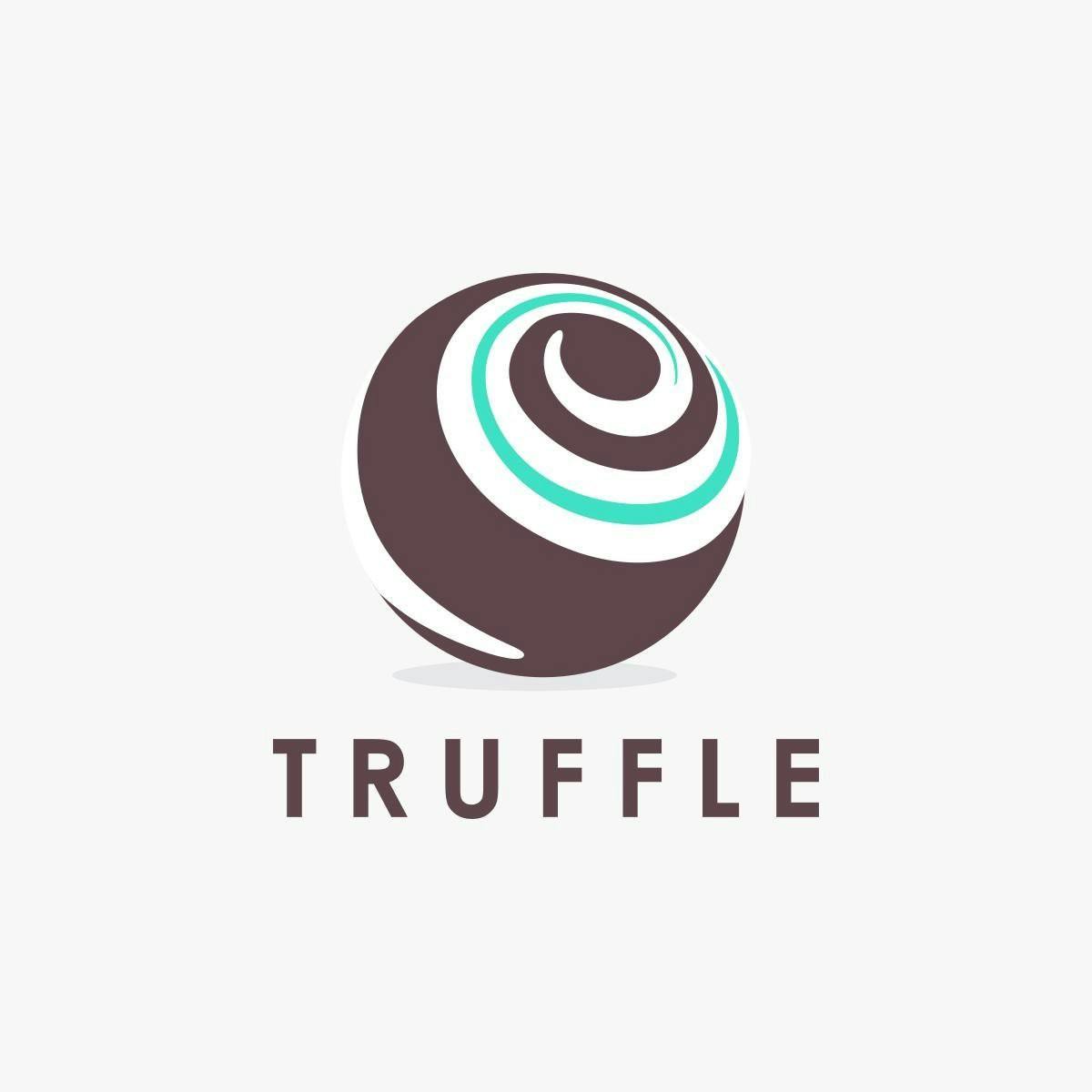
Putting in Ganache
The sensible contracts run on the Ethereum blockchain, so we require one for deployment and testing. We might additionally deploy on a stay chain, however that may value us Ether as a fuel payment. So let’s arrange an area chain and do our testing there. Whenever you’re certain in regards to the code and able to distribute your software, you possibly can deploy it on the stay chain.
Ganache is the native chain put in on our computer systems and runs on localhost. Obtain Ganache from the Truffle Suite website.

We will see that Ganache supplied ten accounts with 100 ETH every. These are faux Ethers, so do not be too excited. Additionally, the chain is operating on 127.0.0.1 at 7545 port. We are going to use these accounts to deploy our sensible contracts on this chain. Ethers will assist us pay fuel charges.
Putting in Truffle
Truffle gives the compiler for sensible contracts. We want it to transform the Solidity code into machine-readable code that may be deployed on the Ganache blockchain.
Set up Truffle utilizing the next command:
$ npm set up truffle -g
Yarn:
$ yarn add truffle
Creating sensible contracts
To create sensible contracts, we first have to create a undertaking listing the place we’ll hold all of the Solidity information. Let’s create one with the identify crud-app and transfer to the listing within the terminal utilizing cd crud-app.
Proper now, our undertaking is empty. To work with it, we’d like some boilerplate code. For instance, if we want to create the UI in React, we’ll want to put in React.
Truffle already gives some packages referred to as boxes. These packages are bundles of various frameworks, corresponding to Truffle, Ganache, React, Web3, and Redux, and there’s one for Vue.js builders. Collectively, they full the end-to-end software growth, from consumer UI to blockchain sensible contracts.
This text will use the React box provided by Truffle.
Putting in the React field
To put in the React field, run the next command:
yarn truffle unbox react
This may set up Web3.js, React, Ganache CLI, Truffle, and Ethereum.
For this tutorial, we can’t concentrate on React or a browser-based UI. As a substitute, we’ll create the sensible contracts and deal with them with the terminal solely.
The listing construction of our undertaking will appear like this:
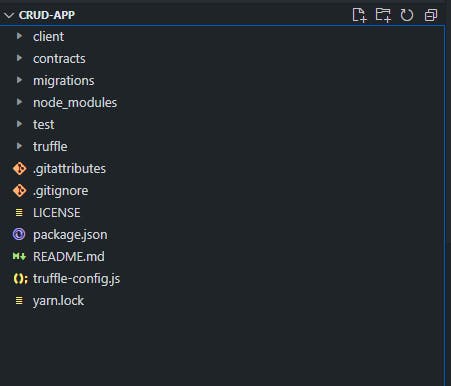
Right here, the consumer is a React undertaking folder the place we are able to create the UI of the applying. A folder inside it consumer/src/contracts holds the compiled sensible contracts in JSON format. These information are generated after we compile our sensible contracts. They include the ABI, bytecode, and different info.
{
"contractName": "Migrations",
"abi": [
{
"inputs": [],
"identify": "last_completed_migration",
"outputs": [
{
"internalType": "uint256",
"name": "",
"type": "uint256"
}
],
"stateMutability": "view",
"sort": "perform",
"fixed": true
},
{
"inputs": [],
"identify": "proprietor",
"outputs": [
{
"internalType": "address",
"name": "",
"type": "address"
}
],
"stateMutability": "view",
"sort": "perform",
"fixed": true
},
{
"inputs": [
{
"internalType": "uint256",
"name": "completed",
"type": "uint256"
}
],
"identify": "setCompleted",
"outputs": [],
"stateMutability": "nonpayable",
"sort": "perform"
}
],
"metadata": "{"compiler":{"model":"0.8.11+commit.d7f03943"},"language":"Solidity","output":{"abi":[{"inputs":[],"identify":"last_completed_migration","outputs":[{"internalType":"uint256","name":"","type":"uint256"}],"stateMutability":"view","sort":"perform"},{"inputs":[],"identify":"proprietor","outputs":[{"internalType":"address","name":"","type":"address"}],"stateMutability":"view","sort":"perform"},{"inputs":[{"internalType":"uint256","name":"completed","type":"uint256"}],"identify":"setCompleted","outputs":[],"stateMutability":"nonpayable","sort":"perform"}],"devdoc":{"type":"dev","strategies":{},"model":1},"userdoc":{"type":"consumer","strategies":{},"model":1}},"settings":{"compilationTarget":{"undertaking:/contracts/Migrations.sol":"Migrations"},"evmVersion":"london","libraries":{},"metadata":{"bytecodeHash":"ipfs"},"optimizer":{"enabled":false,"runs":200},"remappings":[]},"sources":{"undertaking:/contracts/Migrations.sol":{"keccak256":"0x7eaedbb1a3e4e0f585d9063393872f88ded247ca3c3c3c8492ea18e7629a6411","license":"MIT","urls":["bzz-raw://4a3eb571cee910095df65a06a1c1d3f89187c72a3c184ef87a7538d9aa39ad07","dweb:/ipfs/QmdqR3vrSSGR49qFGZr49Mb39z7dgD6tSzEDoaqtM31o61"]}},"model":1}",
"bytecode": "0x6080604052336000806101000a81548173ffffffffffffffffffffffffffffffffffffffff021916908373ffffffffffffffffffffffffffffffffffffffff16021790555034801561005057600080fd5b50610327806100606000396000f3fe608060405234801561001057600080fd5b50600436106100415760003560e01c8063445df0ac146100465780638da5cb5b14610064578063fdacd57614610082575b600080fd5b61004e61009e565b60405161005b9190610179565b60405180910390f35b61006c6100a4565b60405161007991906101d5565b60405180910390f35b61009c60048036038101906100979190610221565b6100c8565b005b60015481565b60008054906101000a900473ffffffffffffffffffffffffffffffffffffffff1681565b60008054906101000a900473ffffffffffffffffffffffffffffffffffffffff1673ffffffffffffffffffffffffffffffffffffffff163373ffffffffffffffffffffffffffffffffffffffff1614610156576040517f08c379a000000000000000000000000000000000000000000000000000000000815260040161014d906102d1565b60405180910390fd5b8060018190555050565b6000819050919050565b61017381610160565b82525050565b600060208201905061018e600083018461016a565b92915050565b600073ffffffffffffffffffffffffffffffffffffffff82169050919050565b60006101bf82610194565b9050919050565b6101cf816101b4565b82525050565b60006020820190506101ea60008301846101c6565b92915050565b600080fd5b6101fe81610160565b811461020957600080fd5b50565b60008135905061021b816101f5565b92915050565b600060208284031215610237576102366101f0565b5b60006102458482850161020c565b91505092915050565b600082825260208201905092915050565b7f546869732066756e6374696f6e206973207265737472696374656420746f207460008201527f686520636f6e74726163742773206f776e657200000000000000000000000000602082015250565b60006102bb60338361024e565b91506102c68261025f565b604082019050919050565b600060208201905081810360008301526102ea816102ae565b905091905056fea2646970667358221220353cb1298ecaaf65fe00ddfd9e11ec1e26a6b97a78dc65de1604cb8b8a399ab364736f6c634300080b0033",
"deployedBytecode": "0x608060405234801561001057600080fd5b50600436106100415760003560e01c8063445df0ac146100465780638da5cb5b14610064578063fdacd57614610082575b600080fd5b61004e61009e565b60405161005b9190610179565b60405180910390f35b61006c6100a4565b60405161007991906101d5565b60405180910390f35b61009c60048036038101906100979190610221565b6100c8565b005b60015481565b60008054906101000a900473ffffffffffffffffffffffffffffffffffffffff1681565b60008054906101000a900473ffffffffffffffffffffffffffffffffffffffff1673ffffffffffffffffffffffffffffffffffffffff163373ffffffffffffffffffffffffffffffffffffffff1614610156576040517f08c379a000000000000000000000000000000000000000000000000000000000815260040161014d906102d1565b60405180910390fd5b8060018190555050565b6000819050919050565b61017381610160565b82525050565b600060208201905061018e600083018461016a565b92915050565b600073ffffffffffffffffffffffffffffffffffffffff82169050919050565b60006101bf82610194565b9050919050565b6101cf816101b4565b82525050565b60006020820190506101ea60008301846101c6565b92915050565b600080fd5b6101fe81610160565b811461020957600080fd5b50565b60008135905061021b816101f5565b92915050565b600060208284031215610237576102366101f0565b5b60006102458482850161020c565b91505092915050565b600082825260208201905092915050565b7f546869732066756e6374696f6e206973207265737472696374656420746f207460008201527f686520636f6e74726163742773206f776e657200000000000000000000000000602082015250565b60006102bb60338361024e565b91506102c68261025f565b604082019050919050565b600060208201905081810360008301526102ea816102ae565b905091905056fea2646970667358221220353cb1298ecaaf65fe00ddfd9e11ec1e26a6b97a78dc65de1604cb8b8a399ab364736f6c634300080b0033",
"immutableReferences": {},
"generatedSources": [],
"deployedGeneratedSources": [
{
"ast": {
"nodeType": "YulBlock",
"src": "0:3176:2",
"statements": [
{
"body": {
"nodeType": "YulBlock",
"src": "52:32:2",
"statements": [
{
"nodeType": "YulAssignment",
"src": "62:16:2",
"value": {
"name": "value",
"nodeType": "YulIdentifier",
"src": "73:5:2"
}
As seen above, client/src/contracts is set to hold compiled code. The development network is set at port 8545. This is the port where this box is running Ganache.
If you look at the top where we installed Ganache, you can see that it was running at 7545 port, but this one is running at 8545 because 7545 is already used by our installed Ganache. If you wish, you can change this port to 7545, and Truffle will use the Ganache and the accounts we installed instead of the one provided by the box. I am keeping it at 8545.
Building a smart contract with CRUD operations
Now it’s time to write some code. We will do CRUD operations and manage a list of technologies.
Our application will show a list of different technologies. You can add, update, and delete the technologies.
If you’ve developed apps before, we’ll follow a procedure you’re undoubtedly familiar with:
- Create an array to hold the names of technologies
- Create a function to push a new value to the array
- Create a function to change the value at a given index
- Create a function to delete a value
- Create a function to return the array
Now let’s write the code in Solidity.
Create a new file in the contracts directory and call it Techs.sol. We’ll start the file by indicating the license and solidity version we are supporting:
pragma solidity >=0.4.22 <0.9.0;
Next, declare the contract scope where we are going to write all the code:
pragma solidity >=0.4.22 <0.9.0;
contract Techs{
}
Create an array to hold the tech stacks:
pragma solidity >=0.4.22 <0.9.0;
contract Techs{
string [] myTechs;
}
This can be a string array with a non-public modifier, which suggests it might probably’t be accessed outdoors the contract; thus, we will not change the worth immediately.
Subsequent, create a perform so as to add a brand new worth:
pragma solidity >=0.4.22 <0.9.0;
contract Techs{
string [] myTechs;
perform addTech(string reminiscence techName) public {
myTechs.push(techName);
}
}
Within the code snippet above, we created a perform referred to as addTech, which accepts a string as a parameter, techName. That is declared public, so the UI or terminal can name it. Within the perform physique, we merely push the worth to the array.
Replace the worth:
pragma solidity >=0.4.22 <0.9.0;
contract Techs{
string [] myTechs;
perform addTech(string reminiscence techName) public {
myTechs.push(techName);
}
perform updateTech(uint techIndex, string reminiscence newTechName) public returns (bool) {
if(myTechs.size > techIndex){
myTechs[techIndex] = newTechName;
return true;
}
return false;
}
}
updateTech accepts two arguments, techIndex and newTechName, and returns a boolean worth. It really works like this: if the index is out of the array’s bounds, it returns false. In any other case, it modifications the worth of the array with a brand new supplied fruit identify on the supplied index and returns true.
The subsequent step is to create the delete perform:
pragma solidity >=0.4.22 <0.9.0;
contract Techs{
string [] myTechs;
perform addTech(string reminiscence techName) public {
myTechs.push(techName);
}
perform updateTech(uint techIndex, string reminiscence newTechName) public returns (bool) {
if(myTechs.size > techIndex){
myTechs[techIndex] = newTechName;
return true;
}
return false;
}
perform deleteTech(uint techIndex) public returns (bool) {
if(myTechs.size > techIndex){
for(uint i=techIndex; i < myTechs.size-1; i++){
myTechs[i] = myTechs[i+1];
}
myTechs.pop();
return true;
}
return false;
}
}
Right here we test the index out of bounds situation after which replace the array by changing the worth with the subsequent worth from the supplied index. This fashion, the worth of the supplied index can be misplaced. In the end, we come out the final worth and return true.
The final step is to return the array. To learn all of the values of the array:
pragma solidity >=0.4.22 <0.9.0;
contract Techs{
string [] myTechs;
perform addTech(string reminiscence techName) public {
myTechs.push(techName);
}
perform updateTech(uint techIndex, string reminiscence newTechName) public returns (bool) {
if(myTechs.size > techIndex){
myTechs[techIndex] = newTechName;
return true;
}
return false;
}
perform deleteTech(uint techIndex) public returns (bool) {
if(myTechs.size > techIndex){
for(uint i=techIndex; i < myTechs.size-1; i++){
myTechs[i] = myTechs[i+1];
}
myTechs.pop();
return true;
}
return false;
}
perform getTechs() public view returns (string[] reminiscence) {
return myTechs;
}
}
Compiling sensible contracts utilizing Truffle
Now that we have completed coding our sensible contract, it is time to compile it utilizing Truffle. However first, we have to create a migration file to point to Truffle that we need to migrate this to the chain.
If we test within the migration folder, we’ll discover a JavaScript file:

The file begins with a quantity, so our second file will start with 2, and so forth. The code is almost customary.
For 1_initial_migrations it’s:
const Migrations = artifacts.require("Migrations");
module.exports = perform (deployer) {
deployer.deploy(Migrations);
};
Let’s add our migration file, 2_techs_contracts:
const TechStack = artifacts.require("./Techs.sol");
module.exports = perform (deployer) {
deployer.deploy(TechStack);
};
We’re able to compile and migrate our techs contract. Transfer to the terminal and run the next:
> truffle develop
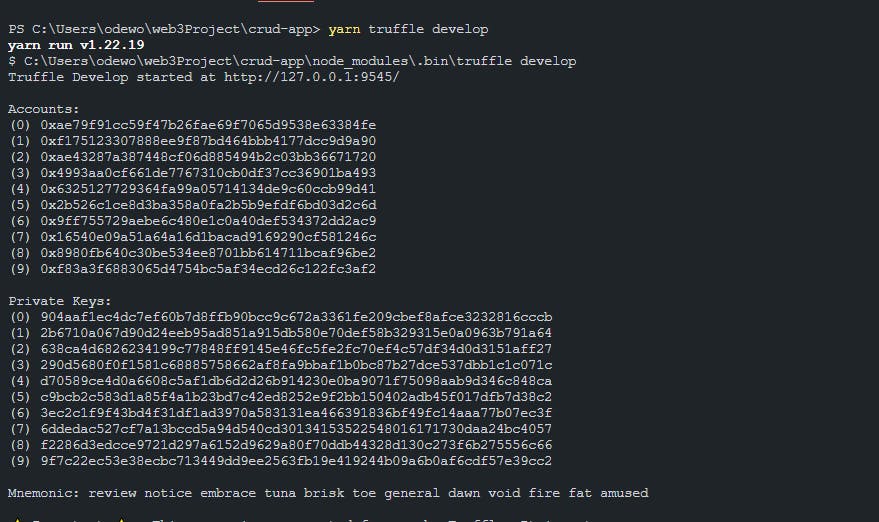
This command will begin the truffle console. It is going to additionally present info such because the chain community, accounts, Mnemonic, and so forth.
Ganache gives ten accounts by default. They are going to be totally different for you. Please do not use any of those non-public keys on the stay chain as a result of they’re seen to all of the guests of this text, which means anyone can entry these accounts.
Now, let’s compile the contracts utilizing this command:
> compile

We will test in construct/contracts whether or not a Techs.json file is created or not.
We will migrate the compiled file to the chain utilizing this command:
> migrate
This may migrate all three sensible contracts to the chain.
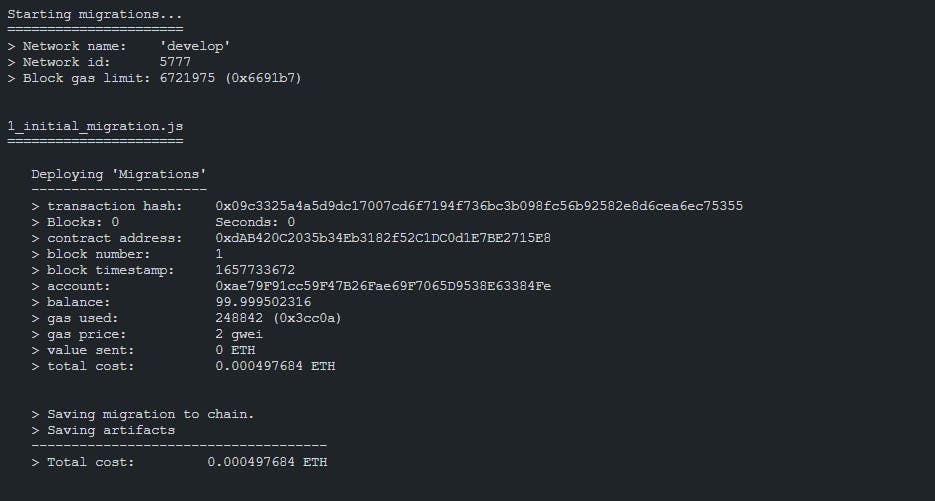
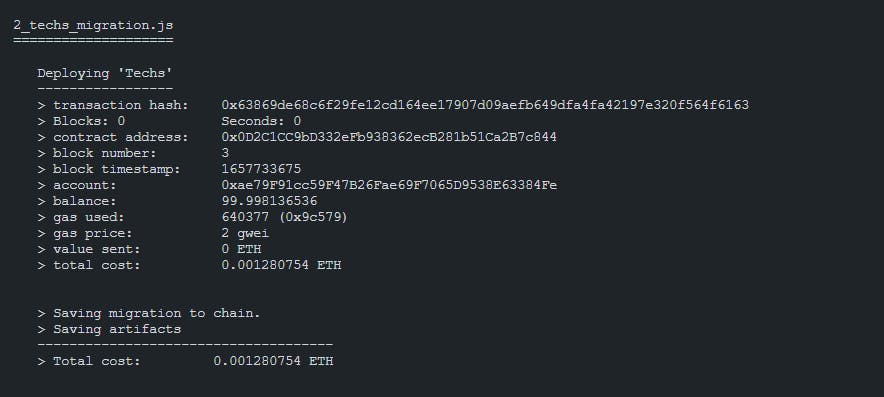

Lastly, our software is on the Ethereum chain. We spent 0.001778438 ETH on fuel charges, and the transactions occurred from the primary account. By default, it at all times takes the primary account. We will carry out numerous operations now.
Getting a Record of Applied sciences
We will use Web3.js to react and write numerous values. Let’s first retailer the occasion of our contract in a variable:
let occasion = await Techs.deployed()
We’re utilizing await as a result of every little thing within the blockchain is asynchronous and returns a promise.
Now use this occasion to get the array:
> let techs = occasion.getTechs()
undefined
> techs
[]
This may return an empty array as a result of our techs array presently has no worth.

Including a Know-how to the record
Let’s add some applied sciences:
> let outcome = await occasion.addTech("JavaScript")
undefined
The outcome will maintain the transaction. This operation provides worth to the array and therefore modifications the information. It’s, due to this fact, recorded as a transaction. Bear in mind, all of the learn operations are free, however any operation that results in a change within the blockchain is topic to a fuel payment.
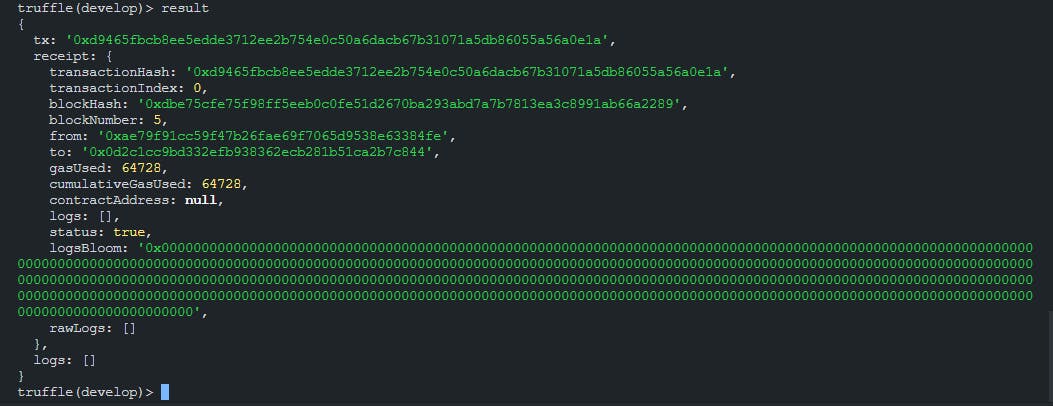
Now we are able to once more learn the array to test the content material:

Let’s add a couple of extra techs to the record:
await occasion.addTech("React");
await occasion.addTech("Nextjs");
await occasion.addTech("Web3.js");
await occasion.addTech("Solidity");
Bear in mind, all these operations will value you Ether. It can save you the payment by making a perform in your contract for accepting a number of fruit values at a time.
Learn the array now:

Updating a Know-how identify
We will see within the above picture that “React.js” was written as “React.” Let’s right it utilizing the updateTech() perform. It is going to settle for the index and new worth. The index is 1.
> await occasion.updateTech(1, "React.js")
Let’s learn the array now:

The spelling is efficiently mounted.
Deleting a Know-how identify
The final operation is to delete a worth:
> await occasion.deleteTech(5)
Learn the values:

The “Svelte” merchandise has been deleted from the record.
Conclusion
Creating sensible contracts and deploying on the blockchain is enjoyable and highly effective. It provides a brand new perspective from conventional programming. You’ll be able to create all kinds of purposes, corresponding to on-line voting, digital financial institution, wallets, auctions and so forth., utilizing these strategies.
On this tutorial, we demonstrated the way to construct a CRUD app with solidity and deploy it on native chain.
To study extra about NFTs, dApps, the blockchain, and different web3 content material, take a look at Hashnode’s web3 blog.









